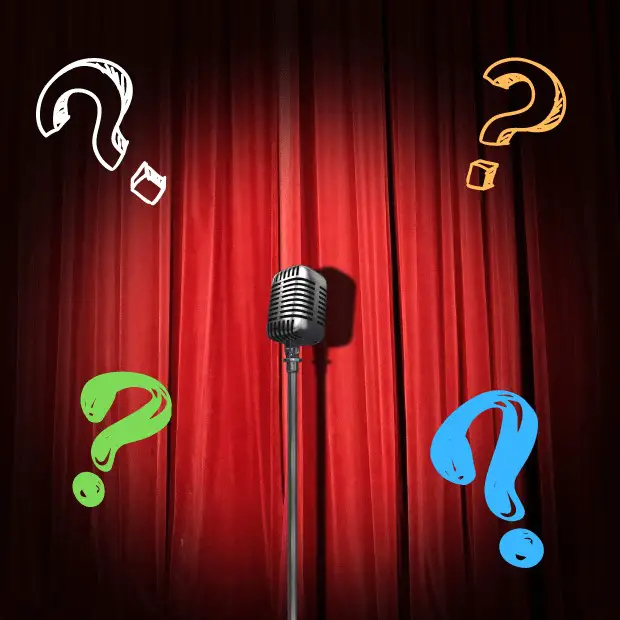
Are you wondering how to write a comedy sketch? Were you struck by a burst of humorous inspiration?
It’s time to put yourself out there, and make other people laugh! Below, we’ll cover all the basics of sketch writing, stand-up comedy, and making your jokes funnier. Let’s get down to it.
How to Write a Comedy Sketch: The Basics
Comedy sketches are often short scenes or vignettes that aim to make other people burst into laughter. They usually have a series of punchlines, jokes, or comedic reactions injected now and then into the dialogue.
1. Come Up With an Idea
Start by brainstorming ideas for your sketch. This could include something you imagined, observed from other people and your surroundings, or a satirical take on recent news and happenings. Jot down those ideas and develop your sketch around them. Depending on your mode of delivery, you can use other tools for comedic effects like props, costumes, lighting, or digital effects.
Establish the parameters such as:
- What is the scene about?
- What is the setting?
- Who are the characters?
- What is the comedic component that will make it into a good sketch?
- What is going to be your unique take on the situation?
- Why should anyone care about what you’re saying?

2. Structure Your Sketch
A typical comedy sketch has a beginning, middle, and end (just like any other story). The beginning should introduce the scene to the audience and set up the conflict or premise of the jokes that will follow. The middle is where most of the action happens. Finally, a resolution or conclusion is presented. There could be a clever twist at the ending, or you’re simply tying up all loose ends so everyone understands what just happened. Of course, not every single detail needs to fall perfectly into place. After all, this is supposed to be funny. Sometimes (or often), there is hilarity in a little chaos. However, having a basic structure will help give your sketch shape and make it easier for audiences to follow along.
3. Punch Up Your Jokes
Now that you have an outline of your Sketch, it’s time to add some jokes! This part will take some trial and error but don’t worry if not every joke gets the reaction you are aiming for. That’s normal! Surprise your readers by playing with the differences between expectations and reality. Keep the punch line brief, surprising, and, of course, funny. Keep working until you find a good balance between dialogue and humor that works well for your particular sketch. And remember: Comedy is all about timing, so pay attention to how you deliver your jokes. A well-timed joke can be hilarious, but a poorly executed one will fall flat.

4. Practice, Practice, Practice
The more you practice your sketch in front of a mirror or by recording yourself on video, the better it will become. Keep tweaking and revising it until you can deliver it without notes. Once you’ve got a solid draft, rehearse it several times before performing it live, and test it on a smaller audience first. This will help ensure that everything runs smoothly and that everyone knows their lines!
5. Have Fun!
Writing comedy sketches can be a lot of work. But ultimately, they should also be enjoyable. Experiment with different ideas and don’t be afraid to sound silly. And there’s no rule saying sketches have to be super serious either. Sometimes the funniest ones are just silly and light-hearted. So go forth and start writing some comedic gold! Key takeaway: Sketches are short, funny scenes or vignettes that are often peppered with punchlines or jokes. Brainstorm ideas, structure your sketch, add jokes, practice, and have fun!
How to Write Stand-Up Comedy
1. Remember that Brevity is Key in Stand-up Comedy
Your jokes should be short and to the point, or complex and elaborate, but that’s much harder to pull off. If you drag on in setting up your punchline, chances are your audience will lose interest before you get to deliver it. So keep your jokes concise and punchy.

2. Focus on Creating Original Content
Don’t just regurgitate material that has been done to death by other comedians. Try to come up with new angles and fresh perspectives on old topics. This way, you’ll make your act more unique and help ensure that your jokes don’t fall flat. There is nothing worse than having most members of the audience say that they’ve already heard your jokes elsewhere.
3. Delivery is Essential in Making Any Joke Work
Proper delivery is especially crucial in stand-up comedy since there will be very limited props or visual aids to rely on or none at all. You can tell funny stories, jokes, limericks, use puns, or even banter with members of the audience. But the bottom line is almost everything must be conveyed through words, facial expressions, and body language. So practice telling your jokes out loud until you’re confident in delivering them flawlessly onstage. With these tips in mind, you should be well on your way to writing stand-up comedy that will have audiences rolling in the aisles. Key takeaway: To write jokes that will get laughs, keep them short and original, and practice your delivery.

How to Get Into Comedy Writing
1. Watch Popular Stand-Up Comedians and Take Note
Study other comics, starting with big names, like Chris Rock, Jerry Seinfeld, or Trevor Noah. Watch their early stand-up followed by more recent shows. Look out for things like how their comedic voices developed over the years. Go to a comedy club for a live show to see how comedians structure their set and comedy scenes. How do they open and close? How many bits are in each set? Sit in the back and observe the audience. How often do they laugh? What do they respond to the most?
Other questions you must ask about successful comedians are:
- What do they have in common?
- Are they all quick with one-liners?
- Do they tell stories that make you laugh out loud?
Use these observations as inspiration for your comedic material.
2. Try Your Hand at Creating Some Original Content
Write down 10 joke ideas or create premises for brief sketches and then work on fleshing them out. Do some revisions as necessary until you have something polished enough to share with others (more on this later). If you’re struggling with writer’s block, there are plenty of resources available online to get you unstuck, such as Comedy Central. There are also plenty of books about sitcom writing and hundreds of online articles full of prompts that can help jumpstart your creativity.
3. Learn How to Handle Criticism Well
One of the most important things you can do as a comedy writer is to become immune to other people’s opinions. Not every joke is going to land, and that’s okay. But the more material you write, the better your chances are of finding those gold nuggets that will make people laugh out loud. Key takeaway: To be a successful comedy writer, start by studying what makes other comedians successful, then practice writing original material. Be prepared to fail and keep at it until you find your comedic voice.
Tips for Writing Funny Jokes
Think about what makes you laugh. What kind of humor do you enjoy? This will give you a good starting point for creating your material. Second, remember that timing is everything in comedy. A well-timed joke can be hilarious, but one that’s off by even a split second can fall flat. Pay attention to the rhythm of your jokes and practice delivering them so they land perfectly every time. Finally, avoid offensive material unless you’re confident in pulling it off without risking getting canceled. If in doubt, err on the side of caution and stick with safer topics.

FAQs on How to Write a Comedy Sketch
1. How do you come up with a sketch idea?
Since sketch comedy is so varied and personal, there’s no single answer to this question.
However, some tips on coming up with ideas for sketches include:
- Thinking about current events or news stories that are ripe for parody.
- Brainstorming funny characters or situations based on real-life experiences.
- Take inspiration from other comedians or comedy shows you enjoy.
Sometimes the best way to come up with a new sketch idea is simply by sitting down and writing out as many random thoughts as possible until something clicks.
2. How do you write a short skit?
An excellent short skit will have a beginning, middle, and end. It should also be funny and brief. A skit does not need to be overly complicated, in fact, the simpler the better.
3. Can I write a skit by myself?
Commonly, only one person writes a skit, but you can co-write with another person or even with several people. If you are writing with someone else, it’s important to discuss the aim of your piece before starting. Decide whether there will be more than one character in your sketch and make sure everyone knows who they are playing.
4. What is a sketch comedy group?
Sketch comedy groups are ensembles of performers who write, rehearse, and perform comedic sketches. Good sketch teams also have an identifiable point of view that comes through in their material, even if they aren’t doing political or topical humor.
5. How do you come up with a skit idea?
Brainstorm ideas for your skit. Jot down all the funny things that have happened to you recently, or any good jokes you’ve heard. You can also look online for inspiration, try searching YouTube or Google for “funny skits” and see what comes up.
6. What is a sketch in writing?
A writer’s sketch refers to the outline or framework of an idea for something that has yet to be written. The word “sketch,” when used as a noun, often describes rough drawings made rapidly and without much detail. Writing sketches before beginning our work on larger projects like novels or plays, may somehow look similar. You jot down quick notes about characters and plot points with little attention paid to language or style (that will come later).

Bonus Section: How to Start Making Skits
1. Premise or Concept for Your Skit
This can be something absurd, like two people arguing over who has the better superpower, for instance. Or, it could be more grounded in reality, like two friends trying to figure out what to do on a Friday night.
2. Characters
You’ll need at least 2-3 characters for your skit. If you’re writing about superpowers, maybe you can have a character who is incredibly powerful and another who might appear weak, but with secret extraordinary abilities. Or if you’re writing about Friday night plans, maybe you have a party animal and his homebody friend.
3. Setting
This could be as simple as “a living room” or “a bar.” Or it could be somewhere outlandish, like a desolate planet or an undersea laboratory.
4. Dialogue
Once you know what’s happening in your skit and who your characters are, it’s time to write some dialogue that furthers the action and reveals information about the characters and their circumstances.
Conclusion
We’ve gone over the basics of writing sketches and stand-up comedy bits. We also gave you some practical tips for making jokes funnier. Now that you know all of this helpful information, what are you waiting for? Get out there and start writing some hilarious sketches! Next up, you may want to explore a guide on humorous writing.
Hey there, welcome to my blog! I'm a full-time entrepreneur building two companies, a digital marketer, and a content creator with 10+ years of experience. I started RafalReyzer.com to provide you with great tools and strategies you can use to become a proficient digital marketer and achieve freedom through online creativity. My site is a one-stop shop for digital marketers, and content enthusiasts who want to be independent, earn more money, and create beautiful things. Explore my journey here, and don't forget to get in touch if you need help with digital marketing.

